
Contents
Can a Bone Fracture Heal on Its Own?
Bones are strong and flexible and can withstand a lot of stress up to a point. A bone fracture is a total or partial break in the bone. If your bone is broken and you don’t know it, it may heal on its own, but it may not heal correctly.
The bones in your body are similar to the branches of a tree. They are strong and flexible up to a point.
Your bones are strong enough to withstand a lot of stress. Sometimes we get used to it and don’t think we’ve broken a bone when we actually have. Like a tree branch, when too much stress is put on one of your bones, the point where the force is the most powerful will fracture.
It’s not always clear if your bone is fractured. If you break a bone without knowing it, the bone will usually heal on its own, but not always correctly.
What is a bone fracture?
A bone fracture is a partial or total break of your bone. The break doesn’t have to be large. It can be less than the width of a hair or less than a quarter of an inch long. It can also completely shatter at the point of the break.
There are many types of bone fractures and different ways that bones can break. Generally, fractures fall into two classifications:
- Open fracture: Your skin is punctured by the broken bone.
- Closed fracture: Your bones did not break through the skin.
Bone fractures can then be broken down further:
- Incomplete fracture: Your bone is only partially broken.
- Complete fracture: Your bone is completely broken.
Fractures are then classified according to their physical characteristics:
- Comminuted fracture: These fractures happen when there are three or more bone fragments at your fracture site. They are sometimes described as a site where the bone is shattered.
- Transverse fracture: This is when your bone completely breaks in a horizontal line.
- Oblique fracture: Your bone’s break is complete and at an angle.
- Linear fracture: A break that runs along your bone’s longer edge.
- Spiral fracture: Your bone is twisted until it breaks.
- Impacted fracture: Your bone breaks, and the pieces are forced into each other.
- Avulsion fracture: A small piece of your bone breaks off, but the rest is still intact.
Bone fracture symptoms
In most cases, you will know when you break a bone. There is always an action accompanied by a force that causes a bone to break.
Sometimes, the symptoms are not as severe. The severity of your symptoms usually depends on the type and classification of your fracture. Some of the symptoms you might experience are:
- Numbness and tingling.
- Intense pain.
- Abnormal appearance.
- Swelling and bruising.
- Problems moving the body part.
- Dizziness or nausea.
Bone fracture causes
Bone fractures are caused by a force acting on the bone. This is true even if your bones have been weakened by a disease like osteoporosis. Health conditions themselves do not cause bone fractures. They increase a person’s risk of breaking a bone.
The leading cause of fractures for all ages is a fall from a standing height. Standing height refers to a person standing or walking without being elevated.
For example, you could trip over a skateboard while walking down your driveway and break your arm when you land.
The second leading cause of fractures is severe trauma, such as a car wreck, recreational accident, or contact sports injury. Falling from a height greater than your standing height is also considered severe trauma because the force of the impact is higher.
Who can fracture a bone?
Anyone can trip, fall, or strike something with enough force to break a bone.
Women are more likely to fracture a bone than men. Their bones are typically smaller and less dense.
Age is a factor, especially in women. Women over the age of 50 are more likely to break a bone than men of the same age.
Smoking decreases bone density for both men and women. It is also linked to accelerating osteoporosis in women.
Contrary to popular belief, both women and men can get osteoporosis.
Other categories of people at risk for breaking bones are athletes and people with physically active hobbies.
People who enjoy risk-taking pursuits such as skydiving or rock climbing are also at risk. People who perform physical work are at risk of bone fractures as well.
Diagnosing a bone fracture
Only a licensed healthcare professional can diagnose a bone fracture.
If you know the signs of a bone fracture, you can reasonably assume you have one. When you see the doctor, they will ask you about your family and medical history and talk to you about the circumstances that led to the suspected fracture.
After conducting a physical examination of the area, doctors use X-rays and bone scans to diagnose a broken bone. A bone scan is a test that uses radiologic imaging when your fracture can’t be seen on an X-ray.
Treatments for a bone fracture
Doctors treat bone breaks based on your type of break and its symptoms.
Medication
Depending on the type of break and treatment, your doctor will prescribe medication to reduce the risk of infections, inflammation, and help with pain relief.
Ibuprofen, corticosteroids, antibiotics, and oxycodone are often used to treat pain and other symptoms of bone fractures.
Surgeries and procedures
Doctors have several options for bone fracture treatment. Treatment also depends on the type and how you fractured the bone. Doctors also must treat any soft tissue conditions that result from a bone fracture.
Fractures that are closed, stable, and set are usually put into a cast and immobilized. Sometimes, doctors use a brace or cast that still allows the joints surrounding your break to move.
Doctors might need to stabilize the bones with plates or rods and screws.
If you have a severe injury where soft tissue is also injured, doctors can use external fixation. Here, hardware is mounted outside of your body until the tissue heals enough to tolerate a surgical procedure.
Complications of bone fracture
Untreated bone fractures can lead to severe infections or misalignment when they heal.
Your fracture could heal and become a deformed bone, limiting your physical activity and reducing your quality of life. If your bones don’t heal correctly, the attached joints might wear out prematurely or become inflamed and cause more problems.
Sometimes, bones don’t heal correctly even with medical treatment. This is uncommon and more likely to happen with severely traumatic injuries. It requires advanced treatment to repair and heal the break.
John Hopkins Medicine: "Bone Scan."
Journal of Bone & Joint Surgery: "The Assessment of Fracture Risk."
Journal of Bone and Mineral Research: "Trends in Fracture Incidence: A Population-Based Study Over 20 Years."
Mayo Clinic: "Fractures & Trauma."
National Institutes of Health: "Osteoporosis."
OrthoInfo: "Fractures (Broken Bones)."
OrthoInfo: "Fractures (Broken Bones)."


